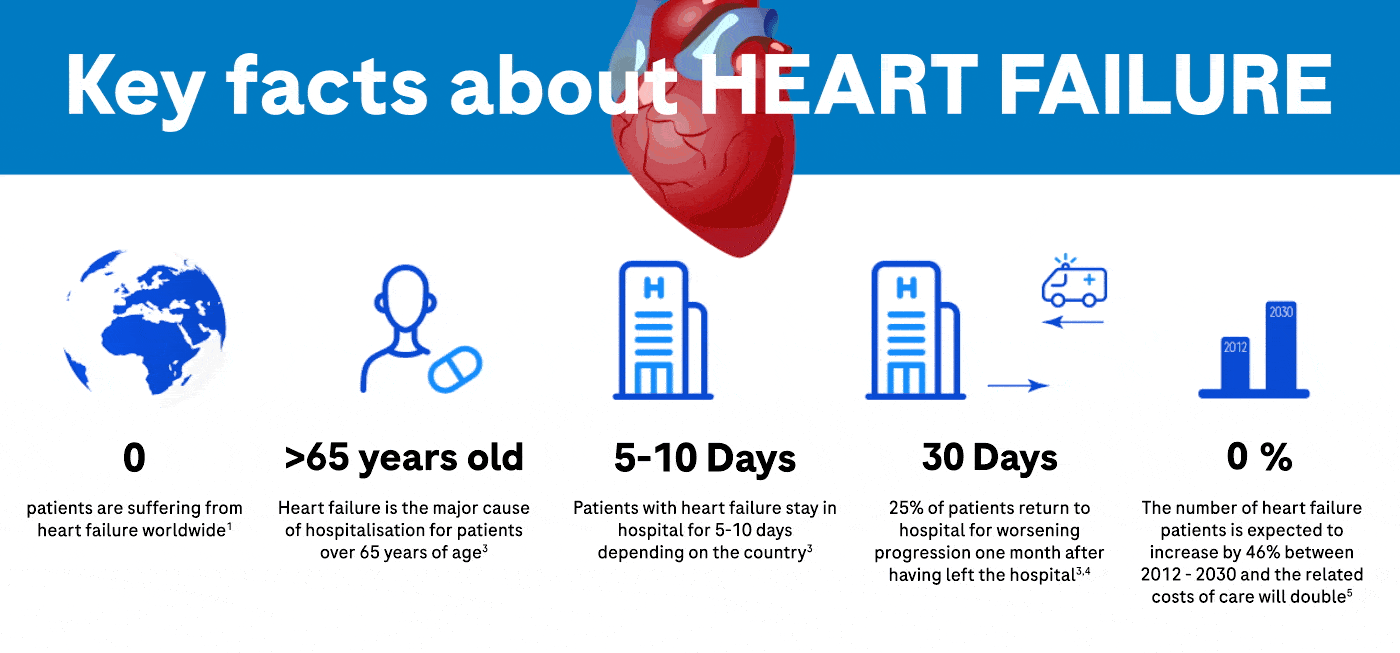As with many types of cardiovascular disease, heart failure is a major challenge for healthcare systems everywhere. Here, we take a look at how clinical labs are contributing to better patient care in heart failure.
Shortness of breath, nausea, fatigue—the symptoms of heart failure can easily be confused for other ailments that are much less serious. This is one of the key reasons why 16.1% of heart failure cases are misdiagnosed in hospitals .1
Heart failure is most commonly caused by damage to the heart muscle, potentially as a result of a heart attack or cardiomyopathy (disease of the heart).2 The disease afflicts roughly 26 million people around the world. Because heart failure diagnosis is a challenge as symptoms are non-specific, and at early stages can even be silent, it can add to a patient’s physical and emotional stress. Data on the direct and indirect economic impacts of ischemic heart disease – a major risk factor for heart failure – suggest that the inadequate management of these conditions can impose billions of dollars of costs on healthcare systems, as well as affect patients in countries where they have to bear significant out of pocket expenses.
Biomarkers tell a more complete patient story
To achieve better patient care, clinicians have turned to biomarkers to tell a better and more complete story. Increasing innovation and advances within diagnostics allow for simple tests to capture data on these biomarkers and in turn provide clinicians more confidence in diagnosing patients effectively and efficiently.3 Laboratory tests not only help to diagnose people with heart failure but also helps screen Type 2 Diabetes Mellitus (T2DM), atrial fibrillation patients at high risk, as well as track disease progression which is key to reducing hospital re-admissions.



patients are suffering from heart failure worldwide1

Heart failure is the major cause of hospitalisation for patients over 65 years of age3

Patients with heart failure stay in hospital for 5-10 days depending on the country3

25% of patients return to hospital for worsening progression one month after having left the hospital3,4

The number of heart failure patients is expected to increase by 46% between 2012 – 2030 and the related costs of care will double5
In heart failure specifically, natriuretic peptides are important for the diagnosis and monitoring of patients. The biomarker of choice is N-terminal prohormone of BNP (NT-proBNP), which is a biological molecule secreted with the movement of cardiac muscles. It is widely considered a gold standard tool in diagnosing and monitoring heart failure.
Read more on heart failure management.
Biomarker usage in acute and chronic heart failure
Heart failure symptoms require significant clinical background to accurately diagnose information that often isn’t available in an emergency department setting. Even with the extensive patient history available in chronic care settings, the accurate interpretation of clinical symptoms may still prove difficult.
“In the emergency department, we are unable to diagnose about one-third of patients that present with shortness of breath,” says Dr David Sim, President of the Heart Failure Society Singapore.4 Yet biomarkers are now being deployed to overcome this uncertainty. For acute heart failure patients in the emergency department, NT-proBNP was able to accurately triage close to 60% of patients with a final diagnosis, according to the ICON study in 2018.5
Another benefit of NT-proBNP is that it can be measured through a point-of-care test, enabling quick turnaround for patients in the emergency department that require rapid results. Other confirmatory methods such as the use of an electrocardiogram, which are not on hand at every medical facility, can be time consuming, resource intensive, and come at a great financial expense to patients, according to Dr Sim.
NT-proBNP also serves as a predictive tool for a patient’s long-term health in a chronic heart failure setting. Changes in NT-proBNP levels, captured through clinical lab diagnostics, allow clinicians to better understand the risks a patient may face in the future and tailor treatments accordingly.
For these reasons, NT-proBNP is recommended as the first one to be performed under the guidelines of the American Heart Association, regardless of the acute or chronic setting, with researchers concurring with this recommendation for an Asian population.4
Putting labs at the heart of it
Without laboratory testing for NT-proBNP, clinicians will be unable to accurately diagnose and treat their heart failure patients. As health systems continue to evolve, the management of diseases like heart failure is critical to ensuring the sustainability of our care delivery models. By including clinical labs as part of effective chronic disease management strategies, health systems can avoid the inevitable strain this growing disease burden will have.

References:
- Wong, C., et al (2021). Misdiagnosis of Heart Failure: A Systematic Review of the Literature. Journal of Cardiac Failure, 27(9), pp.925-933. Retrieved from: https://www.sciencedirect.com/science/article/pii/S1071916421002049?via%3Dihub
- Understanding Heart Failure, Roche Diagnostics. Retrieved from:https://www.roche.com/stories/heart-failure-signs-symptoms-risk-factors
- NT-proBNP: Increasing Clinical Confidence in Heart Failure Management – Cardio ThinkLab (2022). Retrieved from: https://cardiothinklab.com/nt-probnp-increasing-clinical-confidence-in-heart-failure-management
- Evidence-based medicine in heart failure: insights from Prof David Sim – Lab Insights (2021). Retrieved from: https://www.labinsights.com/get-inspired/content/evidence-based-medicine-heart-failure-insights-prof-david-sim
- Januzzi, J., et al (2018). N-Terminal Pro–B-Type Natriuretic Peptide in the Emergency Department. Journal of the American College of Cardiology, 71(11), pp.1191-1200. Retrieved from: https://www.sciencedirect.com/science/article/pii/S0735109718301669?via%3Dihub
- Nichols, G., et al (2001). Congestive Heart Failure in Type 2 Diabetes. Diabetes Care, 24(9), pp.1614-1619. Retrieved from: https://diabetesjournals.org/care/article/24/9/1614/21484/Congestive-Heart-Failure-in-Type-2
- CANVAS study: NT-proBNP and CVD risk reduction – Cardio ThinkLab (2021). Retrieved from: https://cardiothinklab.com/nt-probnp-and-cvd-risk-reduction-in-canvas-study/














